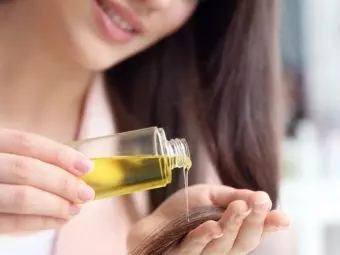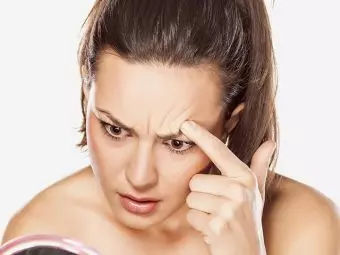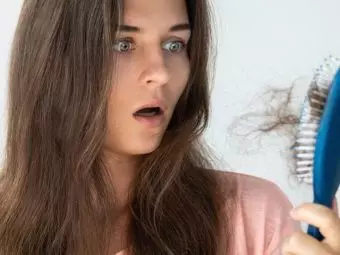You may use high-end hair care products to pamper your hair with utmost care. But your efforts will go in vain if you use an unclean hairbrush. You must clean your hairbrush regularly as it collects product residue, excess oil, grime, dirt, and broken hair strands. In addition, a hairbrush can be the breeding ground for several germs – and warrants regular cleaning and maintenance. This article discusses the most effective ways to clean your hairbrush. Continue reading.
In This Article
Why Should You Clean Your Hair Brush?
The major reason to clean your hair brush regularly is to stay healthy and hygienic. Unclean hair brushes are filled with dirt, natural oils, sweat, dead skin cells, product buildup (leave-in conditioners, gels, and hairsprays), microbes (yeast, bacteria, dust mites, and lice), and hair strands.
Hair brushes become breeding grounds for microbes like bacteria and fungi (yeast) if we do not clean them properly. They transfer grime and germs to your hair, compromising hair and scalp health. This also results in swelling, itching, and dandruff and may lead to folliculitis and seborrheic dermatitis.
Also, the hair brush will not be effective in detangling and brushing your hair. The process of brushing might get painful, leading to hair breakage.
Now that you know how important it is to clean hair brushes, let us move on to the next section for more details about the process.
How To Clean A Hair Brush
1. Remove The Hair
You stroke the hair sideways or vertically while brushing, which means matted hair or foreign matter will get logged in the brush horizontally. Thus, the most important step is to remove all the hair tangled from the brush or comb.
Try to prong out the hair with a toothbrush, toothpick, chopstick, pen, or even the end of a rat-tail comb. A hair pick is best for cleaning wide-spaced, ball-tipped bristles.
You may notice that the hair may be knotted within the bristles. Use scissors to cut the hair stuck between the bristles into smaller pieces. This will not only make hair removal easy but also protect the bristles from separating or getting damaged. You can turn the brush bristle side down and use a toothbrush to clean lint, dust particles, and grime.
Note: You can use any narrow, sharp-edged item that fits between the bristles of the hair brush.
2. Wash The Brush
You Will Need
- A large bowl
- Warm water
- Clarifying shampoo or baking soda
- An old toothbrush, towel, or napkins
Steps
- Add shampoo (dime size or approximately 10 ml) to a bowl of warm water. You can also use your sink instead of a bowl.
- Mix thoroughly to form lukewarm sudsy water. Soak the unclean hair brushes and combs in the warm, soapy water. Depending on the type of hair brush, the soaking duration and cleaning solution will vary.
- Swish the hair brush around the bowl to remove debris.
- Scrub between the bristles gently with a toothbrush. You can also massage the bristle tips with your palms.
- Rinse the bristles thoroughly with warm water.
- Remove excess moisture by patting it dry with a towel or napkin.
Note: Do not soak the hair brushes for a long time or use harsh detergents as the glue that holds the bristles might melt.
3. Dry The Brush
This is an important step to ensure no moisture is left on the hair brush. A moist and damp environment might cause microbial growth. The hair brush will also smell damp and musty if it is not dry completely. In the case of wooden hair brushes, water also increases the risk of wood rotting.
Turn the brush bristle side down on a towel or hang off the edge of the counter. Do not dry hair brushes vertically as it might loosen the bristles.
Can we clean all hair brushes in the same way? Probably not! Simple tweaks will help you clean different types of brushes without damaging them. Scroll down to learn more.
How To Clean Different Types Of Hair Brushes
| Type Of Brush | Method |
| Thermal Brush | Wipe with a soft fiber cloth. You can also dampen the cloth and wipe the brush with it. Do not soak this type of hair brush in water. |
| Natural Bristle Brush | Soak the brush in a mixture of warm water, clarifying shampoo, and tea tree oil (2 to 3 drops) for not more than 10 minutes. |
| Nylon Bristle Brush | Soak the brush in a solution of warm water and baby shampoo for 15 minutes. |
| Mixed Bristle Brush | Soak the brush in warm soapy or shampoo water for 10 minutes. Use castile soap or baking soda for better results. |
| Detangling Brush | Soak the brush in a mixture of warm water and clarifying shampoo for 10 minutes. |
| Paddle Brush | Soak a plastic paddle brush in warm sudsy or mild shampoo water for 10 minutes. For a wooden paddle brush, dip a toothbrush in the cleaning solution and scrub the bristles. |
| Wooden Round Brush | Pour a mixture of warm water, soap, and tea tree oil (2 to 3 drops) on the bristles. Lay it on a towel to dry. Do not wet the wooden part to prevent damage. |
| Metal Round Brush | Soak the brush in a mixture of lukewarm water, shampoo, and baking soda. |
| Curved Brush | Soak the brush in warm soapy or mild shampoo water for 10 minutes. |
| Cushion Brush | Submerge the brush’s bristles in warm soapy water for 5 minutes to loosen dirt and hair. |
| Vented Brush | Submerge the bristles of the brush in warm soapy water and swish around a few times. |
| Teasing Brush | Dip a toothbrush in a warm shampoo solution and scrub the hair brush base. |
| Rat-tail Brush | Soak the brush in a bowl of warm water and baby shampoo for 10 minutes. Use a toothpick or pen to dislodge any hair or debris stuck between the teeth. |
On average, cleaning your hair brushes once a week should suffice. However, this depends on various factors. The next section explains what they are.
How Often Should You Clean Your Hair Brush?
- Excessive Hair Breakage: If you have damaged hair or are experiencing excessive hair fall, chances are your hair brush is always filled with hair. Dry and damaged hair tends to get stuck in the brush easily. This is also observed in people with naturally textured or curly hair.
Note: Remove the hair stuck between the bristles after brushing to prevent the brush from collecting more hair.
- Overactive Glands: If you have a sweaty or oily scalp, your hair brush will get dirty with gunk, grime, and greasiness frequently. Clean your hair brush at least once a week to get rid of the dirt, dead skin cells, and product residue.
- Product Buildup: If you use hair styling products, such as styling creams, dry shampoos, gels, hair mousse, or hair sprays, clean your hair brushes and combs every time you wash your hair. This ensures that your clean hair does not get contaminated by the product residues from dirty hair brushes.
Although soap and water are enough to clean your hair brushes, there are other substitutes to keep your hair brushes squeaky clean. Check out the following section.
What Should You Use to Clean Your Hair Tools?
- Clarifying Shampoo: This shampoo is specifically formulated to eliminate oily residue and grime from the scalp and will clean hair brushes easily.
- Liquid Soap: Use castile soap to dissolve the sticky debris from the hair brush. Castile soap is natural and free of chemicals.
- Baby Shampoo: Baby shampoos are gentle and a great alternative to clean hair tools, such as hair brushes and combs.
- Baking Soda: Add a tablespoon of baking soda to your shampoo before you clean the hair brushes. It is natural, non-toxic, and an effective home remedy for dirt removal.
- Disinfectants: Salons and parlors use industrial-strength disinfectants as their hair tools are used extensively. Also, a UV light-based hair brush sanitizing device has been patented recently to get rid of microbes (1).
Are you using your hair brush past its prime? It is recommended to replace your hair brushes every couple of years. We have a checklist to help you know when it is time to buy a new hair brush. Scroll down to know more!
How Do You Know It Is Time To Replace Your Hair Brush?
Subscribe
Check for the following aspects:
- Is it missing bristles?
- Are the bristles separated?
- Are the bristles wobbly?
- Is the handle or ferrule loose or wearing?
- Is the cushion pad deflated?
If you answer yes to any of the above, go ahead and replace your hair brush.
All your hair care efforts go wasted if you do not clean your hairbrushes regularly and maintain proper hygiene. This habit helps maintain your hair health and prevents scalp infections and irritation. Using an unclean hairbrush causes itching, flaking, swelling, and cause skin conditions like seborrheic dermatitis. You may use simple household items like shampoos, soaps, or baking soda to clean your hairbrushes. Also, remember to replace the brushes, depending on the condition of the bristles. Follow the tips mentioned above to achieve healthy, lustrous, and strong hair.
Frequently Asked Questions
What is the gray stuff on my hair brush?
The gray or white residue on your hair brush is a mix of leftover product or mineral buildup with dead skin cells and dandruff.
Why is my hair brush full of dust?
When you brush your hair, a few strands and debris accumulate on the hair brush. Other factors, such as hair fall, scalp conditions, and pollution, cause a buildup of dust and dirt on the hair brush.
Why does my hair brush stink?
A stinky hair brush can be an indication of scalp infection and inflammation. Consult a dermatologist if the smell persists even after cleaning your hair brush.
Sources
Articles on StyleCraze are backed by verified information from peer-reviewed and academic research papers, reputed organizations, research institutions, and medical associations to ensure accuracy and relevance. Check out our editorial policy for further details.
- Hair brush sanitizing unit
https://patents.google.com/patent/US10058169B2/en
Key Takeaways
- It is essential to clean your hair brush because unclean brushes accumulate dirt, oil, dead cells, and microbes over time.
- You can use clarifying shampoo, liquid soap, or baby shampoo to clean hair brushes.
- If the bristles of your brush are wobbly, separated, or missing, it is time to throw it out and get a new one.
Related
The following two tabs change content below.
- Author
Annie Jangam
Annie Jangam is a researcher-turned-content writer. She enjoys dissecting complex clinical studies and shuffling through the scientific jargon to make… more



 How To Use Jamaican Black Castor Oil For Hair Growth
How To Use Jamaican Black Castor Oil For Hair Growth How To Exfoliate Your Scalp At Home To Clear Excess Oil
How To Exfoliate Your Scalp At Home To Clear Excess Oil How To Apply Oil On Hair: A Step-By-Step Guide
How To Apply Oil On Hair: A Step-By-Step Guide How To Use Coconut Oil For Dry Scalp And Dandruff
How To Use Coconut Oil For Dry Scalp And Dandruff Easy Way To Get The Perfect Twist Out On 4C Natural Hair
Easy Way To Get The Perfect Twist Out On 4C Natural Hair Eyebrow Hair Loss: Causes, Prevention Tips, & DIY Methods
Eyebrow Hair Loss: Causes, Prevention Tips, & DIY Methods Types Of Hair Loss, Causes, Treatments, & Prevention Options
Types Of Hair Loss, Causes, Treatments, & Prevention Options Itchy Scalp And Hair Loss: How To Treat And How To Prevent It
Itchy Scalp And Hair Loss: How To Treat And How To Prevent It What Is Hair Texturizing? How To Take Care Of Texturized Hair?
What Is Hair Texturizing? How To Take Care Of Texturized Hair?